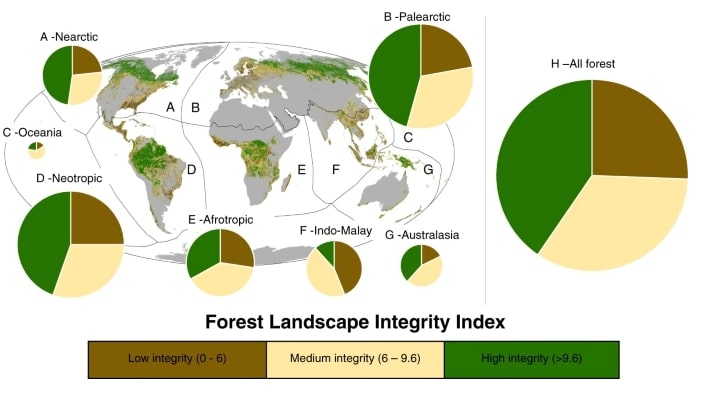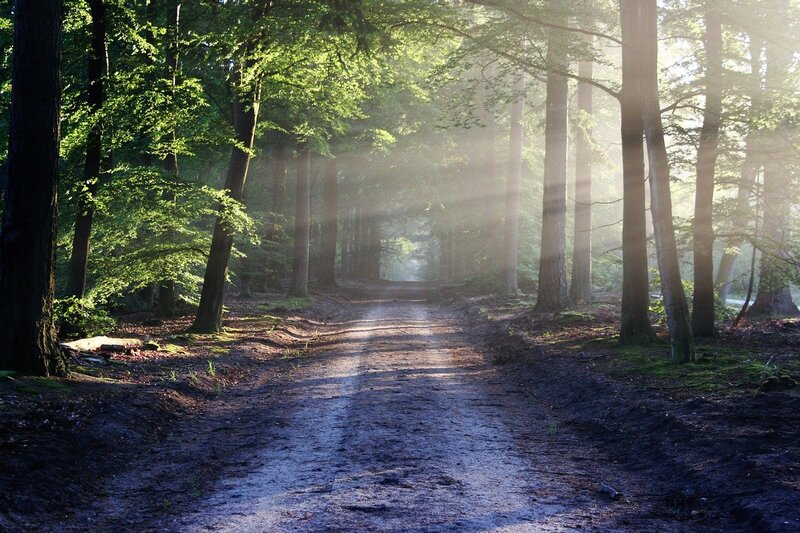Of the world’s remaining forests, only 40% are intact, with high ecological integrity, according to data from the newly developed Forest Landscape Integrity Index, the first of its kind to measure the state of forests on a global scale.
—
A recently published study in the journal Nature Communications describes the Forest Landscape Integrity Index, an open-source tool created by 47 global conservation and forests experts. The index makes use of some of the latest technologies in remote sensing, big data and cloud computing, allowing scientists to measure forest integrity and share the data publicly.
“The index helps fill critical gaps in our understanding of the state of the world’s forests,” Crystal Davis, director of Global Forest Watch, who was not involved in the study, told Mongabay in an email. “The index will help decision-makers identify intact forests most critical for conservation as well as those that should be prioritised for restoration and recovery.”
You might also like: Top 15 Books on Climate Change and Sustainability of 2020

“The Forest Landscape Integrity Index for 2019 categorised into three broad, illustrative classes and mapped across each biogeographic realm (a–g). The size of the pie charts indicates the relative size of the forests within each realm (a–g), and h shows all the world’s forest combined.” Image from Grantham et al. Nature Communications (2020)
According to the index, 17.4 million square kilometres (6.7 million square miles) of remaining forests (40.5%) have high ecological integrity, a measure of human impact calculated using observed human pressure (infrastructure, agriculture, tree cover loss), inferred human pressure based on the proximity to known human pressures, and changes in forest connectivity.
The high-integrity forests are found mostly in Canada, Russia, the Amazon, Central Africa, and New Guinea. Of the remaining high-integrity forests, only 27% are currently in nationally designated protected areas.
Identifying where intact forests remain allows for better planning and management. For instance, the tool has shown large swaths of high-integrity forests remaining in the Central African basin. This information, according to Emma Stokes, WCS regional director for Central Africa, will be used for fine-resolution detailed planning exercises aimed at protecting forests and livelihoods.
“These forests provide livelihoods [for] millions of people, and [are] the cultural and ancestral heart of many indigenous first peoples who live in that area, people who depended on them for tens of thousands of years,” Stokes said.
The map allows users to see the difference in forest integrity across national borders and across regions. In eastern North America, for example, there is a clear gradient from high-integrity forests in Canada to lower-integrity, more degraded forests covering the southeastern United States.
“Its because our market system is broken,” Jamison Ervin, manager of Nature for Development, UNDP, said in a press briefing. “We don’t value forests properly. We value forest by … board feet rather than the value that it provides for our life support systems.”
Conserving forests is a critical part of achieving the international Sustainable Development Goals (SDGs). The current daft of the United Nations Convention on Biological Diversity (CBD) post-2020 Global Biodiversity Framework proposes using ecosystem integrity targets, but, according to Hedley Grantham, WCS director of conservation planning and lead author of the study, discussions on how these targets will be measured are ongoing.
Broad conservation targets aimed at protecting a certain percentage of the world’s forests, such as the 30% by 2030 pledges, are not really enough, said Tom Evans, WCS forest and climate change lead. If the protected forests are of low quality, they are of less value, and more intact ecosystems are more resilient to climate change.
“Forests are the key to maintaining local, national and global water security … they are key to sustaining more than a million forest-based livelihoods, especially for indigenous peoples, they harbor the world’s last in the best places to protect biodiversity, and they’re profoundly important for climate change,” Ervin said. “Simply put, without forests, we cannot achieve the goals of the Paris Agreement … Intact forests are one of our cheapest, most effective nature-based solutions for carbon drawdown with multiple benefits.”
A limitation of the data is that they’re based on a standard forest cover map that includes all woody vegetation, including both self-seeded (natural) as well as planted forests. Planted forests do generally show low integrity scores on the index, Evans notes, but because they are not isolated as a separate category, users would need to find other data sets if they wanted to systematically distinguish among forest types. Another limitation is that some forms of forest degradation, such as the introduction of a non-native species, may not register in the index in some circumstances. However, Evans told Mongabay, “most over-exploitation would register, because it is highly correlated with ease of access and levels of nearby human pressure, which the metric is built around.”
“[W]e encourage people to improve on this at that local level if the data is available,” Grantham said. “But what it also says is that we’ve probably underestimated the loss of forest integrity … our results are probably underestimating this [loss] globally.”
This article was originally published on Mongabay, written by Liz Kimbrough, and is republished here as part of an editorial partnership with Earth.Org.


















